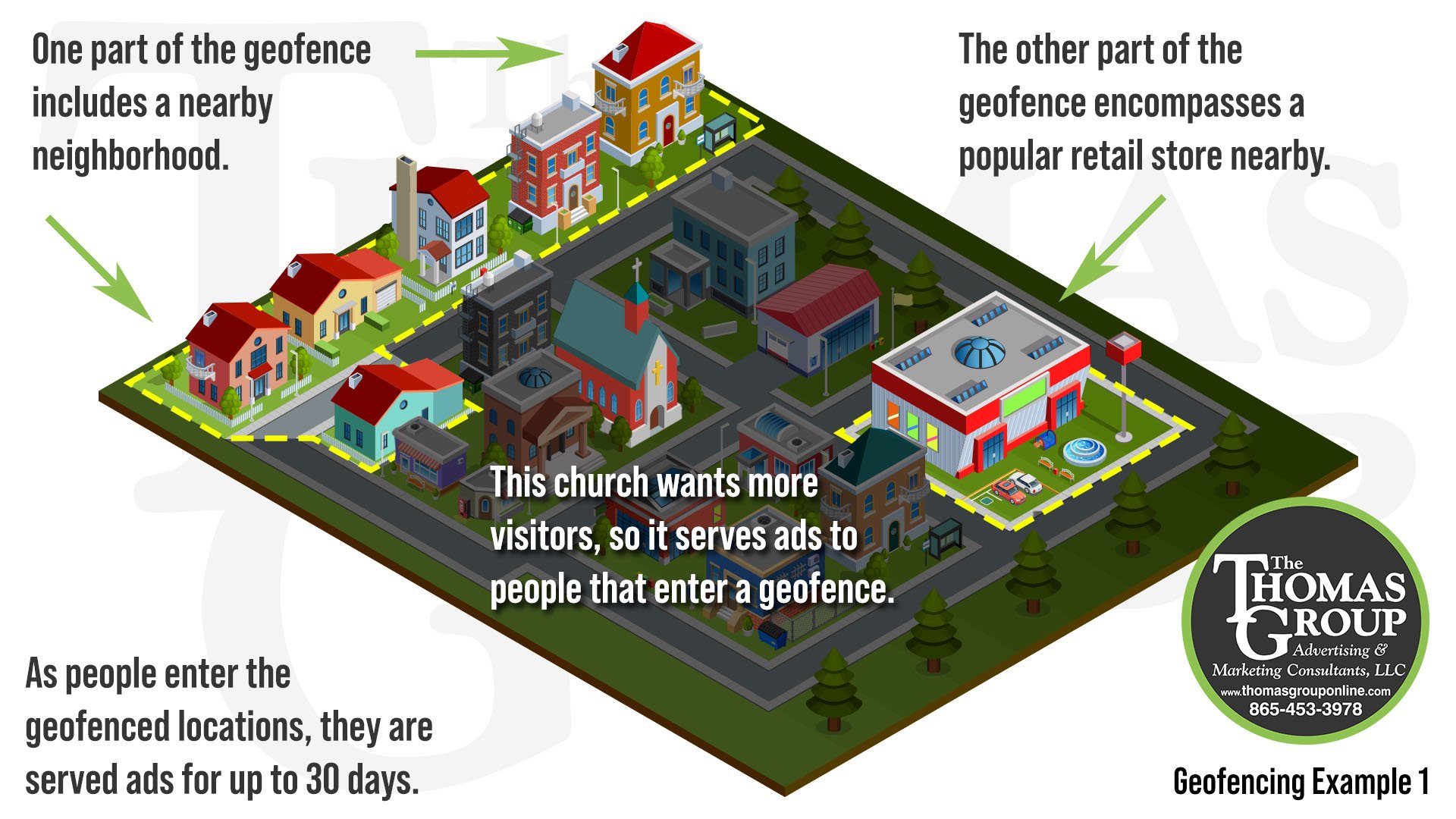Geofencing Ads - A Powerful Way to Reach People
Geofencing ads allow you to serve ads to people in specific locations.
As more and more devices equipped with location tracking are becoming an integral part of our society, geofencing ads are becoming an increasingly popular way of serving ads to people that live in and/or enter a specific area. This specific area is called a geofence and can be as small or as large as you want it to be and can be placed over specific buildings including competitors and likely customers. Geofencing ads are purchased in increments of 1,000, can be served over short and long periods of time, and are just as affordable as other types of digital ads such as Facebook ads (in fact, some geofencing ads may even end up on Facebook!). Geofencing can be complicated so we have laid out some specific examples below. If you have any questions, or would like a quote on geofencing ads, please contact us!
Geofencing Frequently Asked Questions
-
Geofencing ads are sold in increments of 1,000 and come in two varieties, a general geofence and one that includes a list of very specific addresses, such as a mailing list. How much it costs will depend on how many ads you want to serve and for how long, but we normally recommend starting out with at least 25,000 ads per month, which starts at $300. We also charge $75 per hour to design the ads if you do not have someone to design them for you. Typical design time is around 1 hour.
-
The ads are banner and sidebar style ads you have likely seen on your phone, tablet, and computer. Every ad campaign has 5 different ad sizes to accomodate the variety of devices out there.
-
They can show up on websites, in mobile apps, and sometimes they will also be shown on Facebook.
-
You can serve ads for as long or as short as you want, but since geofencing ads are good for building brand recognition we typically recommend serving them for at least 30 days.
-
This depends on what you want to accomplish and who your audience is. For example, if you are a restaurant trying to attract new customers, you likely want to have a fence that includes a lot of nearby residents such as neighborhoods and apartment complexes. However, if the restaurant’s goal is to hire young people for introductory type jobs, they might instead want to draw a fence around nearby high schools where students/young adults might be looking for a job. Think carefully about who you want to show ads to.
-
Yes, you can use a mailing list as your geofence. This kind of geofencing is slightly more expensive, but it can also be more useful as your mailing list could be tailored to a specific audience.
-
We do not recommend your fence including a high traffic road such as an interstate. Many drivers on the interstate are just passing through, so serving drivers ads may not yield good results.
-
Some ads, such as political ads, may have some restrictions, especially in certain states. We will notify you at the beginning if any restrictions may be applicable to your campaign.
-
Geofencing ads can be very effective in reaching your intended audience. However, we highly recommend making your ad memorable/attention grabbing so people are enticed to click on it. For example, a restaurant may want to advertise special pricing that would entice people to try them out. We are the most advertised to society in the history of the world so making ads that stand out are very important.
-
In terms of pricing per impression geofencing ads and Facebook ads are pretty close. Facebook ads typically get more clicks, but you are also limited to people who are specifically on Facebook where geofencing ads will reach just about everyone. Geofencing ads can also be targeted to very specific locations while while Facebook ads can only target a region such as a city or county or state. In other words, you have more control over who might see your ad with geofencing.
-
Google PPC ads are ads that appear when someone is searching for something on Google. This means leads from Google PPC ads might be better qualified since they only show up when very specific keywords are typed into Google’s search platform. However, these ads can be very expensive and, similar to Facebook ads, you can’t target specific locations only regions. Additionally, Google ads are auction based so the competition for them can be high, driving up the cost for popular industries. Geofencing ads will give you significantly more impressions for the same amount of money, but you might see the same or fewer clicks. The average click through rate for geofencing ads is 0.15-0.35% while for Google PPC ads it is 3-5%.
Geofencing Example 1: A Church Wants More VBS Visitors
In the scenario shown above, a church is wanting more visitors for their upcoming Vacation Bible School (VBS). They create a geofencing ad campaign that serves ads to people that enter two nearby locations. The first location is a neighborhood while the other location is a retail store. Anyone who enters either of these areas can be served ads for up to 30 days. Because the ads will come in 5 different sizes, they can be served on a mobile device, a tablet, and/or a computer. Depending on their budget, they might opt to only serve ads to the neighborhood if they feel that the retail store has too many visitors that are unlikely to want to attend their VBS (such as tourists from out of town).
Geofencing Example 2: A Restaurant Has New Hours
In this example, a restaurant has expanded their hours so that they now serve breakfast where previously they only served lunch and dinner. They want to use geofencing ads to inform customers of this change and to attract business for breakfast. The restaurant has a limited budget and only wishes to advertise to businesses and residences that are fairly close by. They also choose to not put a fence around the popular retail store just down the road so that they can run ads in a larger area. If the ads were to be successful, they could later expand their geofence and buy more ads if desired.
Geofencing Example 3: Multiple Campaigns
In this example, a bank has multiple geofencing campaigns going on at one time. Purple buildings are car dealerships so the bank is serving car loan ads to anyone who steps foot in these buildings. Orange buildings are competing banks, so anyone setting foot in these buildings will see ads for mortgage loans at a special rate. Teal building are small businesses that have a B2B business model, limiting foot traffic from customers, and therefore these areas are receiving ads for small business checking accounts.
Geofencing Example 4: Mailing List
In this example, an insurance company has purchased a mailing list for a print and digital ad campaign. The insurance company will be mailing postcards to specific households based on certain demographics, such as income, age, etc., which are represented by the red buildings in the image above. They want to also serve ads digitally to the people on the list which can be accomplished with geofencing. This form of geofencing is more expensive than the examples above, but it can also yield better results if you have already refined the audience you are advertising to.





